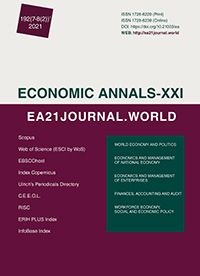Export concentration and diversification impact on economic growth in the developed and developing countries of the world
Export concentration and diversification impact on economic growth in the developed and developing countries of the world
Author(s): Victoriia Dergachova, Alla Dunska, Viktoriia Holiuk, Iryna Lutsenko, Maryna PichuginaSubject(s): Politics / Political Sciences, National Economy, Business Economy / Management, Developing nations, Geopolitics
Published by: Institute of Society Transformation
Keywords: Export Diversification; Export Concentration; Economic Growth; Correlation; Relationship;
Summary/Abstract: There is much evidence that export diversity has a positive effect on economic growth, but there is some evidence that the concentration of exports may be also related to economic growth. The paper is dedicated to the relationship between export diversification and economic growth in developed and developing countries for 25 years (1996-2020) and 10 years (2011-2020). Correlation between concentration index (Herfindahl-Hirschmann Index), diversification index (modified Finger-Kreinin measure of similarity in trade) and economic growth was studied to confirm or deny the statements concerning positive or negative influence of export diversification and concentration on economic growth.The results of the study show that concentration index is lower in developed countries and does not varies much over time. While developing countries show higher magnitudes of this index and higher volatility level of this index and its relationship to the world business cycles. Level of export diversification is higher in developed countries, which show more similar export structure to the world pattern comparing with other national economies. Diversification index dynamics in developed and developing countries was getting closer to each other in 2012-2020 and now they are almost the same, though export diversification level of developed countries is a bit closer to the world export pattern comparing to the developing countries index.The findings show that in developing countries export concentration index has sufficient correlation with their GDP growth rates in both periods. That means the more key goods they sell the higher GDP growth rate they get. There is no long-time influence on economic development of these states according to this lagged correlation study of 1996-2020 period. Study based on 10-year period show sufficient 1-year lagged correlation rate, but the hypothesis concerning lagged positive impact of export concentration of economic development of these countries during the last decade needs proof. Developed countries have weak or moderate correlation between export concentration and GDP growth. Hence, developing countries mostly concentrate their export on a few primary goods but there is a need of additional research to find out if they use this money to develop other industries. Eventually there are different economies in these groups and some of them have different exports patterns and development models.Correlation analysis of the relationship between diversification index and GDP growth in 25-year period has shown weak or rather moderate association that does not give us possibility to make an assumption concerning the sufficient impact of export diversification on economic growth. However, in 10-year study we observe high correlation between these data in developing countries, especially in 5-year lag study. If in case of developing countries we observe positive relationship, analysis of developed countries indices shows negative relationship that confirms the statement about role of export diversification in economic growth of developed counties and export concentration – in developing economies. The more their export pattern deviates from the global structure (which is rather diversified) the higher their growth level is. Therefore, their export consists mostly of a few products. Negative relationship between diversification index and GDP growth in developed countries confirms the well-known statement that export diversification should promote economic growth. Lag dynamics in these cases needs additional studies. The list of issues of the following research also includes the search for a model of the nonlinear relationship between export diversification indices and growth rates in economies of different levels of development.The study has been also focused on the transition economies group, which has shown results more similar to those of developing countries comparing with developed economies. Export concentration index of transition economies is higher than in developing countries and more volatile; export diversification index is much bigger comparing with developing and developed economies. We state that these results reflect existing primary product export strategy of transition economies. The highest concentration and diversification indices are observed in countries that export energy resources.As a result of the study, the statement that the diversity of exports has a positive effect on economic growth was confirmed. The study has revealed that in developed countries economic growth usually are associated with diversified export basket. The study also showed that over the past 25 years, a developing economy to provide growth did not necessarily need diversified export. Number of countries have shown consistent economic growth driven by export of primary products.
Journal: Економічний часопис - ХХІ
- Issue Year: 192/2021
- Issue No: 07+08 (2)
- Page Range: 26-37
- Page Count: 12
- Language: English

